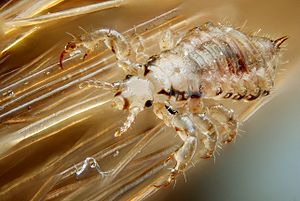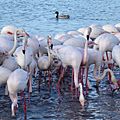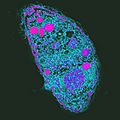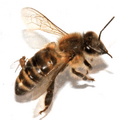Parasitism facts for kids

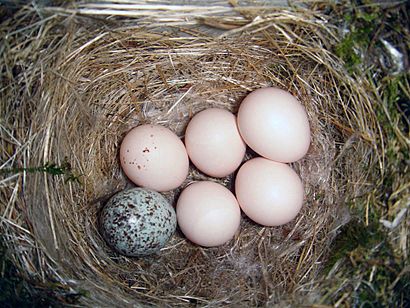
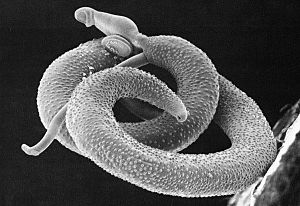
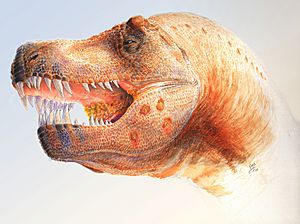
Parasitism is a special way of life where one living thing, called a parasite, lives on or inside another living thing, called a host. The parasite gets its food and shelter from the host.
Sometimes, parasites don't harm their hosts much. But other times, they can cause a lot of damage. Some parasites, called Parasitoids, even kill their hosts. This is different from a mutualistic relationship, where both living things help each other.
For example, tapeworms and leeches can be parasites in humans. One of the most serious parasites for humans around the world is the one that causes malaria.
Here's a simple way to think about it:
- A parasite is an organism that takes nutrients from a living host.
- It lives on or inside another organism.
- It gets all or some of its food from the host.
- It often changes to fit this lifestyle.
- It usually causes some harm to its host.
Contents
Parasites and Humans
Humans can be hosts to many different parasites. We have nearly 300 types of parasitic worms. We also host over 70 types of tiny organisms called protozoa. Some of these parasites have been with us since our early ancestors. Others we picked up from animals we live with or meet. People have known about parasitic infections for a very long time.
Where Do Parasites Live?
When we think about parasites, we often imagine tiny creatures. But many organisms that eat plants can also be seen as parasites. This is because they feed mostly or entirely on one single plant.
For example, many plant-eating insects are parasites. This includes leafhoppers, aphids, and whiteflies. The young forms (larvae) of Lepidoptera (like caterpillars) often live and grow on just one host plant. They get most of their food for their whole life from that plant. These caterpillars can also cause serious damage to the plant's leaves. Other insects like thrips, beetles, and flies also have many plant-parasitic types.
Parasites of larger animals are studied a lot in veterinarian and medical fields. These include tiny viruses and bacteria. They also include protozoa, flatworms (like flukes and tapeworms), and nematodes (roundworms). Even some arthropods like crustacea, insects, and mites can be parasites. Some parasitic wasps and flies are very interesting to scientists. They can even be used to control pests in biological control.
However, some blood-sucking insects, like mosquitoes, only stay on a host for a short time. So, they might not be considered true parasites.
There are a huge number of parasitic species on Earth. One study of insects in Britain found that about 35% were plant parasites. A little more were animal parasites. This means almost 71% of insects in Britain are parasites! Since British insects are well-known, it suggests that most insect species worldwide are parasites. Also, many other invertebrate groups are mostly or entirely parasitic. You can find flatworms and roundworms in almost every wild vertebrate animal. Tiny protozoan parasites are also everywhere. This means that parasitism is likely the most common way of feeding on Earth.
Types of Parasites
- Ectoparasites live on the outside of a plant or animal. Think of a tick on a dog.
- Endoparasites live inside a plant or animal. They can live inside cells (intracellular) or in the spaces between cells (intercellular).
- Parasitoids are organisms whose young grow inside another organism. This always leads to the death of the host. Many types of wasps, like the ichneumonoid wasps, are parasitoids. Their interaction with the host is a bit like predation.
- A vector is a third party that carries the parasite to the host. For example, with malaria, the mosquito is the vector. The Plasmodium protozoan is the parasite, and a mammal (like a human) is the host. The mosquito is also an ectoparasite.
- An epiparasite is a parasite that feeds on another parasite.
- Kleptoparasites steal food from other species.
- Brood parasites (like the Cuckoo) trick other species into raising their young. The Cowbird is another example.
- Social parasites take advantage of how social animals, like ants or termites, interact.
How Parasites Spread and Reproduce
Parasites are very good at living in small, separate places. For a parasite, each host is like an island surrounded by a dangerous environment. It's hard for a small organism to travel between hosts. So, parasites have special ways to overcome this challenge:
- They produce many spores or eggs.
- Female parasites can travel far to find new hosts.
- Some ectoparasites attach to larger animals to move around.
- Their resting stages (like spores or cysts) can live for a very long time. For example, some plant parasitic nematodes can stay inactive for 23 years!
- Many parasites use Parthenogenesis (reproducing without a mate) or inbreeding (mating with close relatives).
Because of this, parasites often live in small groups that are very similar genetically. They have special ways to spread and reproduce.
Parasites are Very Specialised
Parasites live in environments that change over time and in different places. So, you can find different types (or races) of the same parasite in different areas. Also, a single parasite species might have different forms (polymorphism). Parasites are often very picky eaters. Many species only use one host at each stage of their life cycle. Only a few use more than two host species.
Complex Life Cycles
Many parasites have complicated life cycles. For example, flukes are a type of flatworm with over 20,000 species. Most of them infect molluscs (like snails) in the first part of their life. Then, they infect vertebrates (like fish or humans) in the second part.
The life cycle of scrub typhus is even more complex. It involves:
- A bacterium called Rickettsia.
- Chiggers, which are tiny parasitic mites.
- Small mammals, especially rats.
- Scrubby plants in moist areas.
- Humans walking through these areas.
All these things must be in the same place at the same time for the infection to spread. This shows how specific and tricky parasitic infections can be.
How Parasites Change Over Time
Parasites can change and form new species very quickly. For example, in the insect Erythroneura, about 150 times they moved to a new host. This led to about 500 new species in that group!
We can see how many species parasites have. Families of plant parasites are about eight times larger than predator families. Animal parasite families are over ten times larger. This shows how common and successful parasitism is.
Sometimes, we can even see how fast new species appear. For instance, five or more species of the moth Hedylepta likely evolved in Hawaii within 1000 years. This is because they only live on banana plants, which were brought to Hawaii around that time.
Adapting to Many Hosts
Parasites can adapt to many different hosts. This is called Adaptive radiation. How much they adapt depends on:
- How many different types of hosts are available.
- The size of the host population or how spread out it is.
- How long the parasites have had to adapt to their hosts.
- The pressure from the host to change and survive.
Having many different hosts is a big factor. If there are many related host species, then many related parasite species will evolve. For example, mites on Lepidoptera (moths and butterflies) or fleas on mammals and birds show this. A rule called Eichler's rule says: "If you compare a large group of hosts with many different species to a smaller group, the larger group will have more types of parasites."
For example, the two types of oak trees in Britain support about 439 direct parasite species. They also support many more that parasitize those parasites! It's safe to say that British oak trees are home to thousands of parasite species. The large size of these trees helps them host so many parasites. This is true for both plants and animals. A larger bird will have more types of parasites on its body than a small bird.
Longer Time, More Species
One reason large trees have so many parasites is that they might have lived in an area for a very long time. This gives them more time to gather different parasites.
Parasites can also help scientists understand how their hosts are related. Sometimes, new host species have been found because their parasites were different. This means that the ancestors of today's parasites were also parasites of the ancestors of today's hosts.
Co-evolution: A Constant Battle
As a host animal or plant develops ways to defend itself, the parasite also changes to get around these defenses. This is called co-evolution. It's like a constant arms race between the host and the parasite.
Consider two plant families: the Umbellifers (like fennel and parsley) and the Gramineae (grasses). Umbellifers have many strong-smelling chemicals. These chemicals are their defense against plant-eating animals and parasites. Grasses, on the other hand, have a different defense: tiny, hard bits in their cells that wear down the teeth of plant-eating mammals. But they don't have many chemical defenses.
Both families are attacked by leaf-miner flies. There are four times as many grass species as umbellifers. But there are twice as many leaf-miner species on the umbellifers! This is likely because the many different chemicals in Umbellifers have forced the parasites to become very specialized. Eighty-two percent of the leaf-miner species on Umbellifers attack only one type of plant within that family.
Images for kids
-
The head (scolex) of a tapeworm (Taenia solium) has hooks and suckers to attach to its host.
-
The protozoan parasite Trypanosoma is carried by a vector and lives among human red blood cells.
-
Mosquitoes are tiny predators and important carriers of diseases.
-
Borrelia burgdorferi, the bacterium that causes Lyme disease, is spread by Ixodes ticks.
-
Wolbachia bacteria living inside an insect cell.
-
The protozoan Toxoplasma gondii can change the behavior of rats by infecting their brain cells, helping it spread.
-
The dry skin of animals like the short-horned lizard helps keep many parasites out.
-
Leaf spot on oak. The tree's defense chemicals limit the spread of the parasitic fungus, creating circular damaged spots.
-
Saving the California condor from extinction was a big project. But its ectoparasite, the louse Colpocephalum californici, became extinct.
-
A drawing from Francesco Redi's 1684 book about living animals found inside other living animals.
-
Ronald Ross won the Nobel Prize in 1902 for showing that the malaria parasite is spread by mosquitoes. This page from his 1897 notebook shows his first observations.
-
Idiobiont parasitoid wasps immediately paralyze their hosts for their larvae to eat.
-
Koinobiont parasitoid wasps like this braconid lay their eggs inside their hosts, which keep growing.
-
A Phorid fly (center left) laying eggs in a worker honey-bee, which changes the bee's behavior.
-
A hyperparasitoid pteromalid wasp on the cocoons of its host, which is also a parasitoid braconid wasp.
-
The large blue butterfly mimics ants and is a social parasite.
-
The great skua is a powerful kleptoparasite, chasing other seabirds until they drop their food.
See also
 In Spanish: Parasitismo para niños
In Spanish: Parasitismo para niños


